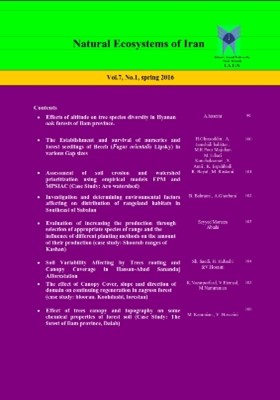Evaluation of increasing the production through selection of appropriate species of range and the influence of different planting methods on the amount of their production (case study: Shoorab ranges of Kashan)
Subject Areas :
forest
morteza abtahi
1
*
1 - استادیار پژوهشی بخش تحقیقات منابع طبیعی مرکز تحقیقات و اموزش کشاورزی و منابع طبیعی اصفهان + سازمان تحقیقات آموزش و ترویج کشاورزی اصفهان ایران
Received: 2015-10-14
Accepted : 2016-05-10
Published : 2016-05-21
Keywords:
Survival,
Desert reclamation,
Ripper,
Hard pan,
production of forage,
Abstract :
The aimes of this research are increase rangeland production of desertes of central Iran and modification of the prevailing conditions fragile wilderness areas through proper identifying the
species and planting them in came into force. In this study, three species: Seidlitzia rosmarinus,
Nitraria schoberi and Zygophyllum eichwaldii by planting potted seedlings treated without operation rippering (breaking the hard layer) was conducted in a split plot based on randomized
complete block design. Rainfed culture was conducted in March and only in the first year of
planting and irrigation was 3 times per year. Traits within 3 years of the project, including survival, height growth, vegetation canopy and production. Statistical analysis of the data
showed that the effect of ripper stay survival, height growth on Seidlitzia rosmarinus
meaningless and maximum vegetation canopy diameter (121.7cm) and production (978 gr) were treated without treatment. Nitraria schoberi was not affected by the plant survival ripper, but the highest growth in height (63.7 cm), vegetation canopy diameter (100 cm) and production (1413.3 gr) was treated ripper. Ripper treatment on Zygophyllum eichwaldii consists of all the characters and most survival (86%), high (63.4 cm), vegetation canopy diameter (73.4 cm) and production (287 gr) treated with ripper has been made. Therefore, Manysurvival and vegetation canopy rate, priority of culture in the region Seidlitzia rosmarinus, Nitraria schoberi and Zygophyllum eichwaldii, respectively. The ripper do not effected on growth and survival of Seidlitzia rosmarinus but effected on survival, height growth, canopy and the production of the Nitraria schoberi and Zygophyllum eichwaldii species.
References:
References
Alavi Panah, K., 1992. Effect of calcium carbonate and calcareous of traveling on the yield of Atriplex foramis enhanced. Study on arid and desert regions seminar, Arid and Desert research center. 87 P.
Bonari, E., M. Mazzoncini and A. Peruzzi. 1995. The effect of four types of tillage operations on soil moisture and morphology and performance of three varieties of cotton. Soil and Tillage Research 33 (3):91-108.
Brown, A. D., A. R. Dexter, W. C. T.Chamen and G. Spoor. 1996. Biological control of paddy brown spot caused by Bipolarisoryzae(Breda de Haan). Soil and Tillage Research38 (2): 203-216.
Cannell, R. Q. and J. D. Hawes. 1994. Modulatory role of methanolic leaf extract of Cissuscornifoliaon blood glucose levels of normoglycemicwistar rats. Soil and Tillage Research30 (6): 245-282.
Cass, A. 2003. Gypsum application and deep ripping far vineyard development. 15:30-33.
Coelho, M. B., L. Mateos and F. L. Villalobos. 2000. Comparative studies of synthesis of Nano-sized ferrite from the thermolysis of di-and tri-phenylamine substituted pentacyanoferrate complexes. Soil and Tilage Research 57 (4): 129-142.
Guérif, J., G. Richard, C.Dürr, J. M.Machet, S.Recous and J. Roger-Estrade. 2001. A review of tillage effects on crop residue management, seedbed conditions and seedling establishment. Soil and Tillage Research,61 (1): 13-32.
Heidari soltanabadi, M. and miran Zadeh, M., 2005. The effect of ripping on some physical properties of soil and sunflower yield in plain mahyar Isfahan. Conference on agriculture in arid and desert, Islamic Azad University, Ardestan.
Hemmati, A., 1997. The results of the experiment of trees adaptation in dryland in Lorestan province, Final report of the project, Research Institute of forests and rangelands. 120P.
KhajeDangolani, S. and M. C.Narob. 2013. Bio-control of bacterial species isolated from diseased citrus fruits by methanolic extracts of weeds in vitro. European Journal of Exprimental Biology 3 (1):694-698.
Kianipoor, A., 2003. Understanding the ecological capability areas. Final report research project sheets Aran., Research Institute of forests and rangelands. 79P.
Lampurlanes, J., Angas, P., and Martines, C., 2001. Root growth. Soil water content and yield of barely under different tillage systems on two soils in semiarid conditions, FieldCrops Research. 69: 27-40.
Lapen, D.R., Topp, G.C., Edwards, M.E., Gregorich, E.G., and Curnoe, W.E. 2004. Combination cone penetration resistance, water content instrumentation to evaluated cone penetration-water content relationships in tillage research, Soil and Tillage Research. 79:51-62.
Lithourgidis, A.S. Dhima, K.V. Damalas, C.A. Vasilakoglou, I.B. and Eleftherohorinos, I.G. 2006. Tillage effects on wheat emergence and yield at varying seeding rates and on labor and fuel consumption. Crop Science, 46.1187-1192.
Salehi, H., 2004. Effect of planting depth and water save on deploying of 5 pasture species. Final research project reports, agricultural and natural resources research center of Isfahan province, 60 P.
Schuster, J. L., H. T. Wiebmann and W.Hanselka. 2002. Soil and Vegetation Management:Keys to Water Conservation on Rangeland. Agricultural Extension Service, Texas, A & MUniversity.
Singh, B.R. and Haile, M. 2007. Impact of tillage and nitrogen fertilization on yield, nitrogen use efficiency of tef (Eragrostis tef (Zucc.) Trotter) and soil properties. Soil and Tillage Research, 94:55-63.
Solhjoo, A.A., Loghavi, m., Ahmadi, h. and Roozbeh, M. 2001. The influence of soil moisture and plowing depth on the soil and reducing the amount of shatter tillage operations, agricultural engineering research journal, 6 (2): 25-33.
Tripathi, R.P. Sharma, P. and Singh, S. 2007. Influence of tillage and crop residue on soil physical properties and yields of rice and wheat under shallow water table conditions. Soiland Tillage Research, 92: 221-227.
Zulfaqar, A, F. Ahmad and F. Irshad. 2003. GIS techniques for rain water conservation in Golestan. Proceedings of the 7thInternational Rangeland Congress, Durban.

